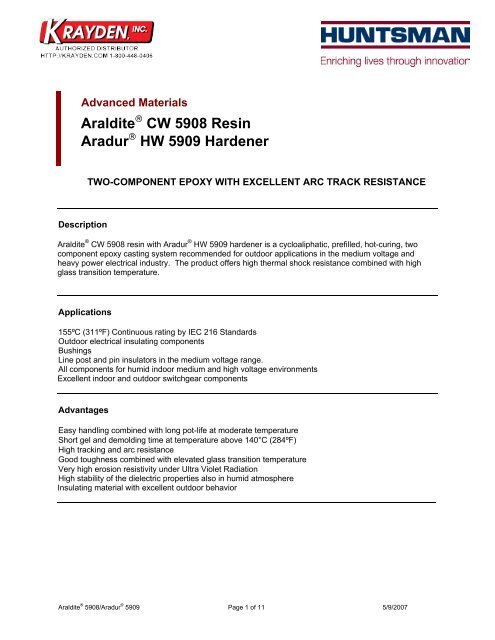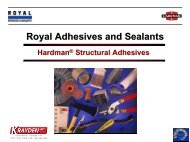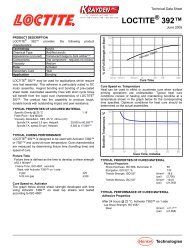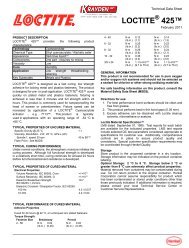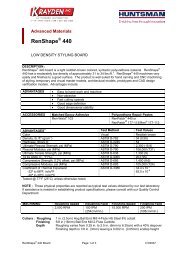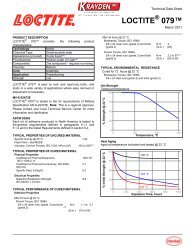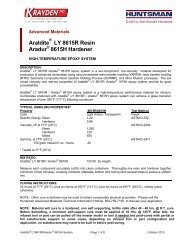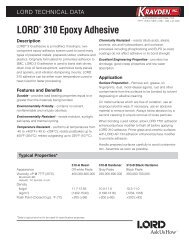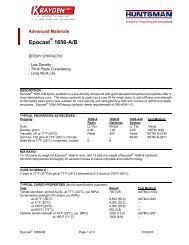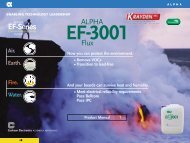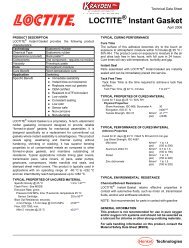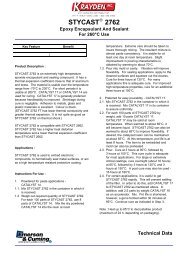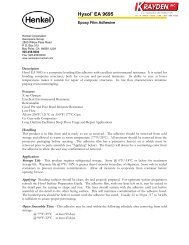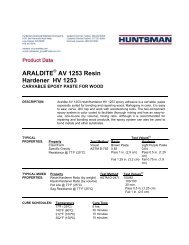Araldite CW 5908 Resin Aradur HW 5909 Hardener - Krayden, Inc.
Araldite CW 5908 Resin Aradur HW 5909 Hardener - Krayden, Inc.
Araldite CW 5908 Resin Aradur HW 5909 Hardener - Krayden, Inc.
You also want an ePaper? Increase the reach of your titles
YUMPU automatically turns print PDFs into web optimized ePapers that Google loves.
Advanced Materials<strong>Araldite</strong> ® <strong>CW</strong> <strong>5908</strong> <strong>Resin</strong><strong>Aradur</strong> ® <strong>HW</strong> <strong>5909</strong> <strong>Hardener</strong>TWO-COMPONENT EPOXY WITH EXCELLENT ARC TRACK RESISTANCEDescription<strong>Araldite</strong> ® <strong>CW</strong> <strong>5908</strong> resin with <strong>Aradur</strong> ® <strong>HW</strong> <strong>5909</strong> hardener is a cycloaliphatic, prefilled, hot-curing, twocomponent epoxy casting system recommended for outdoor applications in the medium voltage andheavy power electrical industry. The product offers high thermal shock resistance combined with highglass transition temperature.Applications155ºC (311ºF) Continuous rating by IEC 216 StandardsOutdoor electrical insulating componentsBushingsLine post and pin insulators in the medium voltage range.All components for humid indoor medium and high voltage environmentsExcellent indoor and outdoor switchgear componentsAdvantagesEasy handling combined with long pot-life at moderate temperatureShort gel and demolding time at temperature above 140°C (284ºF)High tracking and arc resistanceGood toughness combined with elevated glass transition temperatureVery high erosion resistivity under Ultra Violet RadiationHigh stability of the dielectric properties also in humid atmosphereInsulating material with excellent outdoor behavior<strong>Araldite</strong> ® <strong>5908</strong>/<strong>Aradur</strong> ® <strong>5909</strong> Page 1 of 11 5/9/2007
TypicalPropertiesTest ValuesProperty <strong>5908</strong> <strong>5909</strong>Specific Gravity 1.74 – 1.80 1.77 – 1.83Viscosity, @ 40ºC (104ºF), cPAs supplied formFlash Point, Closed Cup, ºC(ºF)Vapor Pressure @ 25ºC (77ºF),N/m 2 12,000 – 24,000Gray viscousliquid> 200 (>392)< 0.017,500 – 15,000Beige viscous liquid165 (329)< 0.3* Typical properties are based on Huntsman’s test methods. Copies are available upon request.Packaging & Storage<strong>Araldite</strong> ® <strong>CW</strong> <strong>5908</strong> resin: Store at 21-32ºC (70-90°F) in a dry and well-sealed condition, ifpossible, in original containers. If only part of container is used, re-close to preventcontamination.<strong>Aradur</strong> ® <strong>HW</strong> <strong>5909</strong> hardener: Store at 21-32ºC (70-90°F) in a dry well-sealed condition, ifpossible in original containers. This product is moisture sensitive and packaged under a blanketof dry nitrogen. Maintain factory seal. If only part of container is used, blanket with dry nitrogenand tightly re-seal.Under these conditions their shelf lives will be one year from date of shipping. ContactCustomer Service for packaging information.System PreparationThe two components should be mixed in the desired quantity under vacuum and at slight elevatedtemperature (up to 60°C/140ºF). For mixing of medium- to high- viscous casting resin systems and formixing at lower temperatures, we recommend special thin film de-gassing mixers that may produceadditional self-heating of 10ºC -15 °C (50ºF – 29ºF) as a result of friction. Depending on the quantity,mixer device, mixing temperature and application, the mixing time is, under a vacuum of 1 to 8 mbar,0.25 to 1 h.The premixed components are packaged according to their mixing ratio. To minimize any fillersedimentation, it's recommendable to empty the container completely. Before partial use, the contentsmust be carefully homogenized at elevated temperature. We recommend also the same preheatingtemperature to prevent air entrapment.<strong>Araldite</strong> ® <strong>5908</strong>/<strong>Aradur</strong> ® <strong>5909</strong> Page 2 of 11 5/9/2007
In automatic feeding and mixing installations, both components are degassed and homogenizedunder a vacuum of about 2 - 5 mbar in separate holding tanks. From time to time the prefilledproducts are agitated to avoid any sedimentation and irregular metering. After dosing and mixing witha static mixer, the system is fed directly to the vacuum casting chamber or, in case of the automaticpressure gelation process, directly to the hot casting mold. Several individual casting stations can befed via separate feeding tubes.The effective pot-life of the mixed system is about 1 to 2 days at temperatures below 25°C (77ºF).Conventional batch mixers should be cleaned once a week or at the end of work. For longerinterruptions of work, the pipes of the mixing and metering installations must be cooled and cleanedwith the resin component to prevent sedimentation and/or undesired viscosity increase. Interruptionsover a weekend without cleaning are possible if the pipes are cooled at temperatures below 18°C(64ºF). For information regarding viscosity increase and gel time at various temperatures, refer toFigures.1 and 3.Mold temperatureAPG processConventional vacuum casting130 - 160°C (266 – 320ºF)80 - 100°C (176 – 212ºF)Demolding times (depending on mold temperature and casting volume)APG process10 - 40 minutesConventional vacuum casting 4 – 8 hoursCure conditions (minimal postcure)APG processConventional vacuum casting2 hours at 150°C (302ºF) OR5 hours at 140°C (284ºF)2 hours at 150°C (302ºF) OR5 hours at 140°C (284ºF)To determine whether cross-linking has been carried to completion and the final properties areoptimal, it is necessary to carry out relevant measurements on the actual object or to measure theglass transition temperature. Different gel and post-curing cycles in the manufacturing process couldinfluence the cross-linking and the glass transition temperature respectively.Mix ratiosParts by weight<strong>Araldite</strong> ® <strong>CW</strong> <strong>5908</strong> 100<strong>Aradur</strong> ® <strong>HW</strong> <strong>5909</strong> 100<strong>Araldite</strong> ® <strong>5908</strong>/<strong>Aradur</strong> ® <strong>5909</strong> Page 3 of 11 5/9/2007
Reactivity Characteristics:100000[mPa·s]8000060000Figure 180°C60°C4000040°C2000000 0.5 1 1.5 2 3 4 6 8 12 16 20 [h] 24Viscosity increase at 40, 60 and 80°C (measurements with Rheomat 115) (Shear rate D = 10 s -1 )1E5Figure 2[mPa·s]1E41E31E210 30 50 70 [°C] 90Initial viscosity as a function of temperature(measurements with Rheomat 115, D = 10 s -1 )<strong>Araldite</strong> ® <strong>5908</strong>/<strong>Aradur</strong> ® <strong>5909</strong> Page 4 of 11 5/9/2007Typical Cured Properties
1000[min]Figure 310010170 90 110 130 150 170Gel time measured as a function of temperature(measurements with Gelnorm Instrument / DIN 16945/ 6.3.1)[°C]160[°C]140120140°CFigure 41008060120°C100°C401E1 1E2 1E3 [min] 1E4Glass transition temperature as a function of cure time(isothermic reaction, IEC 1006)<strong>Araldite</strong> ® <strong>5908</strong>/<strong>Aradur</strong> ® <strong>5909</strong> Page 5 of 11 5/9/2007
Mechanical and Physical Properties (typical values)PropertyTest ValueTensile strength. psi 10,500 – 12,000Elongation at break, % 1.50 - 1.70E modulus from tensile test, psi 1.40 - 1.48 x 10 6Flexural strength, psi 17,000 – 20,000Surface strain, % 1.8 - 2.0E modulus from flexural test, psi 1.45 - 1.50 x 10 6Double Torsion TestCritical stress intensity factor (KIC), MPa·m ½ 2.3Specific energy at break (GIC), J/m² 500Glass transition temperature DSC, °C (ºF) 115 – 132 (239 – 270)Coefficient of linear thermal expansion See Figure 6Mean value for temperature range: 20-100°C, °C -1 30 - 35·10 -6Thermal conductivity, W/mK 0.75 - 0.85FlammabilityThickness of specimen: 4 mmClass HBThickness of specimen: 12 mm Class V-0Water absorption (specimen: 50×50×4 mm)10 days at 23°C (75ºF), % by wt 0.20 - 0.24in boiling water at 100°C, % by st See Figure 7Specific Gravity 1.801E10G' [Pa]1E9Figure 5G'1E1tan δ1E01E81E7tan δ1E-11E-21E61E-3-150 -100 -50 0 50 100 150 200 [°C]Shear modulus (G') and mechanical loss factor (tan )as a function of temperature(ISO 6721/ DIN 53445,methode C, measured at 1Hz)Figure 6<strong>Araldite</strong> ® <strong>5908</strong>/<strong>Aradur</strong> ® <strong>5909</strong> Page 6 of 11 5/9/2007
150[1E-6/K]120906030AluCuFe0-50 0 50 100 150 [°C] 200Coefficient of linear thermal expansion ()as a function of temperature(DIN 53752 / reference temperature: 23°C)10Figure 7[Gew. %]10.10 50 100 150 [h] 200Water absorption at 100°C as a function of time(specimen: 50×50×4 mm, DIN 53495/1L)<strong>Araldite</strong> ® <strong>5908</strong>/<strong>Aradur</strong> ® <strong>5909</strong> Page 7 of 11 5/9/2007
Electrical Properties (typical values)Determined on standard test specimen at 23°C (75ºF)Cured for 2h at 100°C (212ºF) + 10h at 140°C (284ºF)Breakdown strength(Test specimen with encapsulatedRogowski electrodes, gap: 1 mm, kV/mm) 35 - 38HV arc resistance, sec. 195 – 210<strong>Inc</strong>lined Plane Tracking and Erosion TestInitial Tracking Voltage (i.t.v.), kV/min 3.5/50Time to Track@ 2.5 kv. (t.t.t.), min. > 2,000@ 3.5 kv. (t.t.t.), min. > 300Figure 816141210tan δ [%]86 ε r42010 50 90 130 [°C] 170Loss factor (tan δ) and dielectric constant (εr) as a function of temperature(measurement frequency: 50 Hz / IEC 250/ DIN 53483)<strong>Araldite</strong> ® <strong>5908</strong>/<strong>Aradur</strong> ® <strong>5909</strong> Page 8 of 11 5/9/2007
Figure 91E18[Ω cm]1E161E141E121E101E810 50 90 130 [°C] 170Volume resistivity (ρ) as a function of temperature(measurement voltage: 1000 V/ IEC 93/ DIN 53482)<strong>Araldite</strong> ® <strong>5908</strong>/<strong>Aradur</strong> ® <strong>5909</strong> Page 9 of 11 5/9/2007
Handling/Safety PrecautionsMandatory and recommended industrial hygiene procedures should be followed whenever our productsare being handled and processed. For additional information please consult the corresponding materialsafety data sheets.<strong>Araldite</strong> ® <strong>CW</strong> <strong>5908</strong> <strong>Resin</strong>Warning! Causes skin and eye irritation. May cause allergic skin reaction. Avoid contact with eyes,skin, and clothing. Avoid prolonged or repeated contact with skin. Do not breathe dust. Wash thoroughlyafter handling. Notice! Contains crystalline silica. Breathing dust may cause cancer and delayed lunginjury.<strong>Aradur</strong> ® <strong>HW</strong> <strong>5909</strong> <strong>Hardener</strong>Warning! Causes eye, skin, and respiratory irritation. May cause allergic skin and respiratory reactions.Avoid contact with eyes, skin, and clothing. Avoid breathing vapor or mist. Avoid prolonged or repeatedcontact with skin. Keep container closed. Use with adequate ventilation. Wash thoroughly after handling.Notice! Contains crystalline silica. Breathing dust may cause cancer and delayed lung injury.Caution:Huntsman Advanced Materials Americas <strong>Inc</strong>. maintains up–to-date Material Safety Data Sheets(MSDS) on all of its products. These sheets contain pertinent information that you may need to protectyour employees and customers against any known health or safety hazards associated with ourproducts. Users should review the latest MSDS to determine possible health hazards and appropriateprecautions to implement prior to using this material. Copies of the latest MSDS may be requested bycalling our customer service group at 888-564-9318 or emailing your request toelectronics@huntsman.com.FIRST AID!Eyes and skin: Flush eyes with water for 15 minutes. Contact a physician if irritation persists. Washskin thoroughly with soap and water. Remove and wash contaminated clothing before reuse.Inhalation: Remove subject to fresh air.Swallowing: Dilute by giving water to drink and contact a physician promptly. Never give anything todrink to an unconscious person.KEEP OUT OF REACH OF CHILDRENFOR PROFESSIONAL AND INDUSTRIAL USE ONLY<strong>Araldite</strong> ® <strong>5908</strong>/<strong>Aradur</strong> ® <strong>5909</strong> Page 10 of 11 5/9/2007
IMPORTANT LEGAL NOTICEHuntsman Advanced Materials warrants only that its products meet the specifications agreed with the user. Typicalproperties, where stated, are to be considered as representative of current production and should not be treated asspecifications.The manufacture of materials is the subject of granted patents and patent applications; freedom to operate patentedprocesses is not implied by this publication.While all the information and recommendations in this publication are, to the best of Huntsman Advanced Materials’knowledge, information and belief, accurate at the date of publication, NOTHING HEREIN IS TO BE CONSTRUEDAS A WARRANTY, WHETHER EXPRESS OR IMPLIED, INCLUDING BUT WITHOUT LIMIATION, AS TOMERCHANTABILITY OR FITNESS FOR A PARTICULAR PURPOSE. IN ALL CASES, IT IS THE RESPONSIBILITYOF THE USER TO DETERMINE THE APPLICABILITY OF SUCH INFORMATION AND RECOMMENDATIONS ANDTHE SUITABILITY OF ANY PRODUCT FOR ITS OWN PARTICULAR PURPOSE.The behavior of the products referred to in this publication in manufacturing processes and their suitability in anygiven end-use environment are dependent upon various conditions such as chemical compatibility, temperature, andother variables, which are not known to Huntsman Advanced Materials. It is the responsibility of the user to evaluatethe manufacturing circumstances and the final product under actual end-use requirements and to adequately adviseand warn purchasers and users thereof.Products may be toxic and require special precautions in handling. The user should obtain Safety Data Sheets fromHuntsman Advanced Materials containing detailed information on toxicity, together with proper shipping, handling andstorage procedures, and should comply with all applicable safety and environmental standards.Hazards, toxicity and behavior of the products may differ when used with other materials and are dependent onmanufacturing circumstances or other processes. Such hazards, toxicity and behavior should be determined by theuser and made known to handlers, processors and end users.Except where explicitly agreed otherwise, the sale of products referred to in this publication is subject to the generalterms and conditions of sale of Huntsman Advanced Materials LLC or of its affiliated companies including withoutlimitation, Huntsman Advanced Materials (Europe) BVBA, Huntsman Advanced Materials Americas <strong>Inc</strong>., andHuntsman Advanced Materials (Hong Kong) Ltd.Huntsman Advanced Materials is an international business unit of Huntsman Corporation. Huntsman AdvancedMaterials trades through Huntsman affiliated companies in different countries including but not limited to HuntsmanAdvanced Materials LLC in the USA and Huntsman Advanced Materials (Europe) BVBA in Europe.Main Offices:Huntsman Corporation10003 Woodloch Forest Dr.The WoodlandsTexas 77380(281) 719-6000Huntsman Advanced TechnologyCenter8600 Gosling Rd.The WoodlandsTexas 77381(281) 719-7400© 2007 Huntsman Advanced Materials Americas <strong>Inc</strong>.<strong>Araldite</strong> and <strong>Aradur</strong> are registered trademarks of HuntsmanCorporation or an affiliate thereof in one or more, but not all,countries.<strong>Araldite</strong> ® <strong>5908</strong>/<strong>Aradur</strong> ® <strong>5909</strong> Page 11 of 11 5/9/2007


